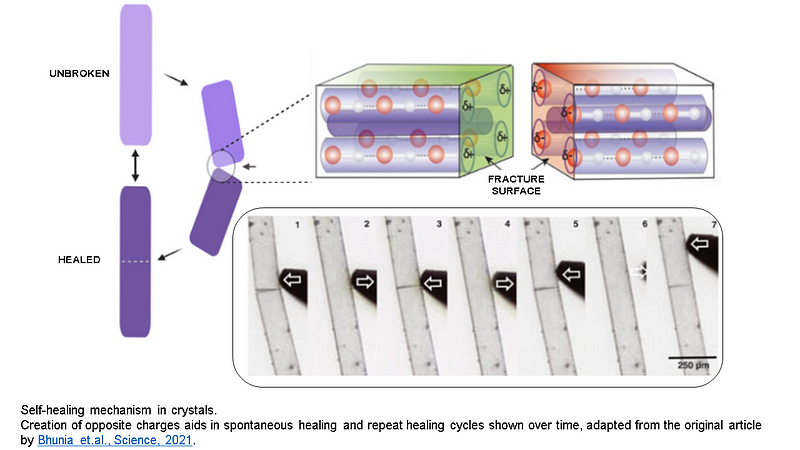Revolutionizing Self-Healing Materials: A Dive into Piezoelectricity
Written on
Chapter 1: Understanding Piezoelectricity
Piezoelectricity refers to the phenomenon where specific materials generate an electric charge in response to applied mechanical stress. This charge accumulation plays a significant role in the healing processes of living tissues, such as bones and soft tissues. This intriguing property has spurred a new field within materials science, focused on exploring the self-healing capabilities found in both natural and synthetic substances. Recently, a groundbreaking study from Dr. C. Malla Reddy’s research team at IISER Kolkata introduced a novel class of piezoelectric crystals. Their findings, published in a 2021 issue of Science, demonstrated that these crystals could spontaneously reconnect after being mechanically fractured without any external assistance.
Several existing self-repairing synthetic materials are typically soft and amorphous, requiring extended physical interaction and additional triggers like heat or pressure to facilitate their healing processes. Surojit Bhunia, the lead PhD researcher and first author of the study, highlights that the exploration of self-healing mechanisms is relatively new, dating back only about ten years. He notes, “Replicating this behavior in polymers, which have been thoroughly studied, poses significant challenges.” Various polymer compounds and gel-like substances suitable for biomedical and industrial applications have emerged through the chemical engineering of such materials. However, achieving similar molecular behavior in crystalline structures is complex due to their highly ordered molecular arrangements and rigidity, which hinder matter diffusion, a contrast to synthetic polymers and composites.
Section 1.1: Breakthroughs in Crystal Engineering
Malla Reddy’s team at IISER Kolkata specializes in crystal engineering, focusing on organic crystals with flexible properties. The discovery that self-healing could occur in these crystals was unexpected. During experiments with organic materials that maintained crystalline properties, researchers observed that certain samples could instantly repair themselves following microscopic damage. “It was a fortunate accident, and we recognized the potential when we noted the significant attractive forces recombining the fractured components,” remarks Prof. Reddy. This piezoelectric effect-driven recombination occurred within milliseconds and exhibited remarkable crystallographic precision. The major hurdle was designing appropriate experiments and selecting the right techniques for analysis. Collaborating with Prof. Nirmalya Ghosh’s team at IISER Kolkata enabled them to probe structural changes at the nanoscale.
Subsection 1.1.1: Characterization of Healing Mechanisms

In their characterization of the crystal properties, they identified that the self-healing effect was present in crystals capable of charge accumulation. The tetramethyl bipyrazole crystals discovered by the IISER team naturally aligned molecular dipoles, resulting in opposite electric charges forming at rupture sites and enabling spontaneous recombination so precise that the repaired material is indistinguishable from its original state.
Section 1.2: Implications for Future Research
The fundamental insights gained about the physical transformations in materials undergoing self-healing represent a significant advancement, particularly within organic crystals. As Surojit notes, “This mechanism is distinct from the diffusion-based healing observed in soft organic materials. Even bones and biopolymers like collagen in the human body exhibit piezoelectric properties, allowing them to self-repair minor nanoscale cracks.” This discovery opens the door for exploring a wide variety of materials.
An additional consideration for biomedical applications is the lower toxicity of organic materials. The low-voltage signals generated by their inherent piezoelectricity are typically much less than those found in inorganic composites. Piezoelectric transducers are already widely used in industrial machinery for applications like scanning probe microscopy and energy harvesting. Improving the durability of these materials can significantly enhance device performance. A research team from IIT Kharagpur, which contributed to understanding the role of piezoelectricity, is currently investigating these new crystals for potential use in energy-harvesting devices.
While the prospects of this technology are promising, Surojit emphasizes that it is unlikely to lead to self-healing smartphones in the near future. The research team is more focused on delving deeper into the fundamental properties of piezoelectric crystals and diversifying material types, paving the way for innovative applications.
Chapter 2: Video Insights into Piezoelectric Phenomena
The first video titled "Piezoelectricity - Why Hitting Crystals Makes Electricity" explores the fundamental principles of piezoelectricity and its implications in various fields.
The second video, "How Electricity in Your Bones Makes Them Stronger | Piezoelectric Effect," discusses the relevance of piezoelectricity in biological systems, particularly in enhancing the strength and healing of bones.
Written by Edna George, Meheli Banerjee, and Snigdha Bhowmick